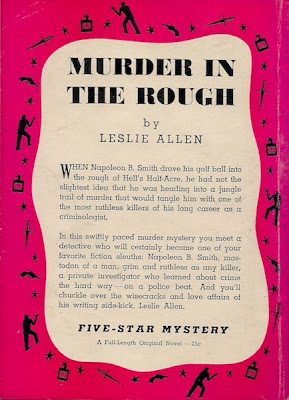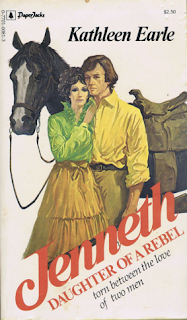Murder in the Rough
Leslie Allen [pseud. Horace Brown]
New York: Five Star Mysteries, 1946
Having never stumbled upon a murder victim myself, I view sleuths who do so with some suspicion. Believe me, the law will one day catch up with Jessica Fletcher. That said, I'm willing to give private detective Napoleon B. Smith, the star of Murder in the Rough, the benefit of the doubt.
Where The Penthouse Killings, Horace Brown's 1950 mystery, has too many characters, here their number is so very small. Ignoring late entries, we have only Jack, Gale and Cyrus, coroner Thomas Bryce and Adam Johnson, the Cartwright family lawyer. There's also Napoleon B. and Allen, of course, along with Inspector Joe Brownlee, but this reader was correct in discounting them as persons of interest.
When Jack is murdered, Gale is nearly blown to bits by her stepmother's booby-tapped coffin and Napoleon B. dodges assassination by air rifle, accusatory fingers point to handsome Cyrus, "North American skeets champion, a successful manufacturer of small arms, including some adaptations of high-powered German compressed-air rifles, and an active leader in boys' work."
But Cyrus is just too obvious, isn't he?
The break in the case occurs when Napoleon B. grabs Gale and begins to "whipsaw her lovely face." Allen looks on:
"Cut it out!" I yelled. "Napoleon B., are you crazy?"The information she's kept to herself brings things to the sharpest of points. When the murderer is finally revealed, some fifty or so pages later, there is no surprise.
He was paying no attention. The methodical blows were not easy ones.
"The police are in the house." Blow. "They'll be here in a moment," Blow. "Are you going to talk?" Blow. "Are you?" Blow. "Are you?"
There was blood on her cheek. It all took only several seconds. He was talking through his teeth. I knew it was no use to interfere.
"Yes!" The word was faint: "Yes!"
Having stood by during the bloody inquisition, is it any wonder that Allen does not get the girl in the end?
Trivia: While cover copy would have you believe that Napoleon B. Smith is destined to become "one of your favorite fiction sleuths," he disappeared after Murder in the Rough.
Dedication:
According to Myrna Foley, the author's daughter, Newman was content to let rent payments lapse until her father was able to make a sale. The rental in question, a house on Fairport Beach Road in Dunbarton (now Pickering), still stands.
Here's to Harry A. Newman, K.C.!
Object: A slim, digest-size paperback in glossy paper wraps, apparently 60,000 words in length.
The cover illustration, which I quite like, is wrong to feature blood on the golf ball.
Access: A scarce title. The Toronto Public Library has a lonely non-circulating copy somewhere in its stacks, but that's it for Canada. Only two copies are listed online – both Very Good copies, they're priced at US$60 and US$85.
































